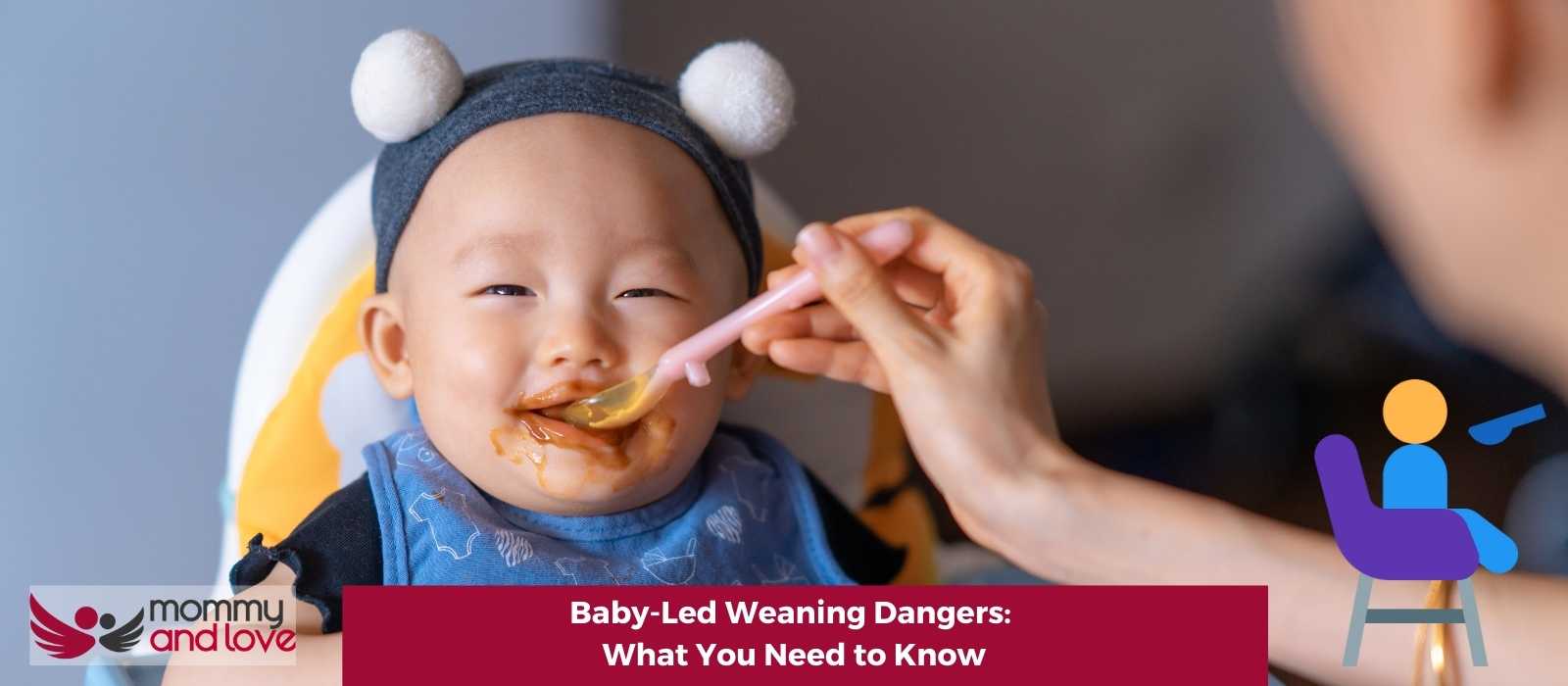If you are like most new parents, you are probably researching different methods of weaning your baby from the breast or bottle. One method that has been gaining in popularity in recent years is baby-led weaning.
This approach to weaning allows babies to feed themselves solid foods as they become more interested in them, rather than being spoon-fed by a caregiver.
While the benefits of baby-led weaning have been recognised for some time now, there’s no doubt that many moms are still concerned about certain baby-led weaning issues: issues that many regards as ‘dangers’.
If you – and your baby – are going to succeed if you start baby-led weaning when introducing solid foods, it’s really important that you both feel comfortable and confident. So if you’re one of those moms, who considers certain baby-led weaning issues ‘dangers’, let’s look at the issues and help put your mind at rest!
First off, we should point out that, over the last decade, there have been multiple studies carried out, which are designed to check out the safety of this method called baby-led weaning! So we have plenty of material to work with!
Is Baby-Led Weaning Feasible For Your Child?
We should point out, however, that baby-led weaning is NOT recommended for all babies. Physical issues can be barriers to this form of feeding and certain developmental milestones have to have been met.
So make sure you’re aware of the following criteria before starting your baby out on baby-led weaning. Developmental readiness is vital in a baby-led weaning approach.
- Never start the process with a baby less than 6 months old.
- If your baby has a tongue or lip tie issue that hasn’t been sorted, then no baby-led weaning. With this form of feeding, a young child feeding needs to be able to easily move food around with their tongue and around in their mouth to reduce the choking risk. So if your baby is affected by a tongue or lip tie, this will not be possible until the issue is resolved.
- If your baby has a cleft lip or palate, this can make biting, chewing and swallowing more challenging due to the unique physical structure of their mouth.
- If your baby is affected by a low muscle tone of the lips, tongue or jaw (a condition known as hypotonia), then this will affect their ability to manage food in their mouth.
The ‘Dangers’ of Baby-Led Weaning vs Spoon-Feeding
While the benefits of baby-led weaning are many and varied there’s no doubt that the process does carry certain perceived ‘dangers’.
Danger #1 – Increases The Risk of Your Baby Choking
This is the main danger as perceived by many moms, who worry that baby-led weaning is more likely to cause their baby to choke than spoon-feeding or other complementary feeding practices.
Is this one of YOUR concerns?
Yes? Well, Mom, here’s the good news…
On top of the fact that there’s no evidence to suggest that babies are more likely to choke with baby-led weaning, you need to remember that your baby has a strong gag reflex, so you’ll always be able to tell the difference between your baby gagging and your baby choking.
If your baby is gagging, they’ll probably cough and go red in the face.
If they’re choking, however, they’ll be silent. Learn how to deal with choking episodes and when your baby is eating solids, never ever leave him unattended.
With baby-led feeding, you are more likely to get a log of gagging noises when you introduce solid foods. When they start to eat finger foods their tongue will naturally repel it, due to the gag reflex. This is perfectly normal and nothing to worry about. Studies have proven there is NO increased risk of choking with a baby-lead weaning approach.
When you do a baby-led introduction, start with soft foods for infant food.
Danger #2 Your Baby May Not Be Getting Enough Iron

After the age of 6 months, your baby needs lots of iron and some moms don’t use baby-led weaning for fear that their baby won’t be getting enough iron.
This ‘danger’ hasn’t been helped by studies like the one that found baby-led weaning babies consumed ‘higher intakes of fat and saturated fat, and lower intakes of iron, zinc and vitamin b12’.
Put simply, if you’re offering baby the right types of foods – those which are nutritionally rich – then the idea of baby not getting enough iron simply won’t be an issue.
Many baby-led weaning enthusiasts may tell you that you should feed your baby what you’re eating. That’s fine if you have a super healthy diet that contains all of the necessary nutrients.
But what if you don’t have a healthy family diet?
Your baby has specific nutritional needs and so the food that you’re cooking for the rest of the family may not have everything that your baby needs.
This ‘danger’ is easily remedied by ensuring that your family foods all incorporate iron-rich foods. Dinners that feature black beans – say in burrito bowls – are an ideal way of ensuring that your baby gets what they need nutritionally.
If your family suffers from any genetic conditions that affect their iron absorption, like hemochromatosis, then it’s important to continue your normal diet and speak to your doctor about your child’s diet.
Also, offering your baby iron-rich meats, such as meat, pulses and fortified cereals at every mealtime will ensure that all nutritional needs are met. Avoid sweet foods and certain foods which have little to offer infant nutrition or iron deficiency.
Period.
Danger #3 Your Baby May Not Be Able To Eat Enough Solid Foods

If you’re finding that even though your baby has reached the 6-month stage but is still unable to grasp objects between their thumb and index fingers (this is known as the pincer grasp, don’t panic!
Some babies aren’t able to manage the pincer grasp until between 9 and 12 months.
As with anything, with patience, your baby will learn to do this. You could start by offering your child the stick or chunk of food so that it can take it from your fingers.
Also, experiment with different types of finger foods until you find one that your baby CAN lift in their pincer grasp.
Yes, it’s messy and you can end up with food in places that food shouldn’t be, but as with anything else your baby does, they’ll have fun learning to do baby-led weaning.
Never leave your baby on their own though. In any case, you’ll have fun sharing this activity with your baby….the cleaning up can wait!
The Bottom Line is Baby-Led Weaning Safe?
If you’ve chosen to go down a baby-led weaning style of self-feeding instead of the conventional complementary feeding style (spoon-feeding and pureed food) then yes you need to not only watch your baby eat, but also ensure the nutrient intake and diet quality is adequate for their needs.
A lot of these can be mitigated by avoiding high choking risk foods and ensuring that when infant feeding you offer plenty of iron-containing foods.
Food preferences are set early in life, and a baby-led approach to solid food in early childhood can ensure that baby-led infants eating the same foods as the family have much healthier eating behaviours compared to those with traditional weaning styles.
When compared to a traditional weaning approach, in a randomised controlled trial of New Zealand families, children who were given a baby-led weaning process had much healthier eating behaviour with a normal body mass index, whilst those on a traditional weaning approach has an increased risk of obesity when they were older.
However, remember, the world health organization recommends that exclusive breastfeeding and breast milk should be the main source of food and energy intake for babies up to 12 months old. Milk feeds should always be a priority in the weaning period, with complementary foods being just that – complementary.

This article was written by Sandra Baker – full time writer and the mother of four amazing kids (including twins!)
She’s also a breastfeeding counselor and has spent years helping new parents learn how to care for their children. When she’s not writing or caring for her children, Sandra likes to spend time reading and taking walks with her husband.




